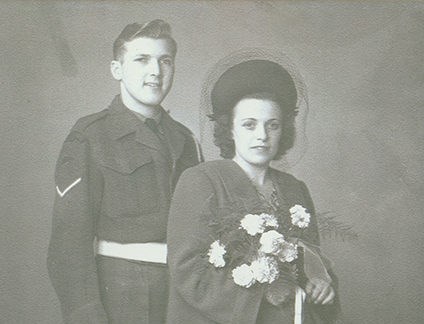 By Tom Slater and Tom St. Amand
By Tom Slater and Tom St. Amand
Late in 1944, a chance encounter at a dance hall in Brussels changed their lives forever.
He was an 18-year-old Sarnian and a member of the Military Police with the Canadian forces that had helped liberate Belgium that September. She was a 21-year-old Belgian seamstress who lived with her parents and her five siblings.
He was Protestant, she was Catholic – but that mattered little to them. When Tom Jennings and Maria Schauvaerts began dancing together, they shared an instant and mutual attraction.
“They looked at each other and it was love at first sight,” their daughter, Joanna, recalled her parents telling her.
As their courtship began, Tom and Maria shared their life stories.
In 1942, when Tom was attending SCITS, he quit school to enlist at age 16. His father, Charlie, was serving as a firefighter in England, and Tom wanted to join him there. He was too young but joined the Canadian Armed Forces in 1943 with his mother's consent.
Hoping to become a paratrooper, Tom completed basic training at Camp Ipperwash and arrived in England. At 17, he was too young to serve on the front, but during his extra training, he became such a proficient shot with PIAT (Projector, Infantry, Anti-Tank) guns that he trained other soldiers. The PIAT was a new and powerful armour-piercing weapon that foot soldiers could carry and use to damage enemy tanks.
Although Tom planned to become a paratrooper, his superiors had other plans. In 1944, Tom was deployed to Belgium as a member of the Canadian Forces Military Police, an agency tasked with enforcing discipline among Canadian soldiers. After Belgium was liberated on September 2, Tom attended dances to celebrate the event and met his future wife at one.
Like other Belgian families throughout the war, the Schauvaerts did not have much. Maria did some babysitting, and her work as a talented seamstress helped support her family.
Months before the liberation, however, the Germans forced her to work in one of their factories. Her new job was to sew the seat cushions they needed for their trains.
Maria had no choice, but resented her captors' cruelty. After a Jewish neighbour was taken to Auschwitz, Maria completed a small but meaningful act of rebellion.
“She took one of her seat cushions,” Joanna stated, “and crammed it with fish guts before sewing the cushion up. She risked her life, but she wasn't caught.”
Tom and Maria were married in Brussels and lived in Sarnia shortly after the war ended. They were blessed with four children and Tom supported his family by becoming a milkman at Silverwoods Dairy and then a firefighter for 37 years.
Tom and Maria's upbringings and experiences had forged their personalities and solidified their marriage. After living through the Depression and witnessing war's cruelties, they instilled in their children the importance of being kind and generous to those in need.
And they never lost their love of music and dancing.
Tom was a self-taught musician who played several instruments and had been performing in bands all his life. Tom and Maria often walked 15 kilometres to dance at Kenwick on the Lake in Bright's Grove.
Maria passed away in 1989 and only in his final years did Tom talk about the war to his family. The war had given him Maria, but had taken away many paratroopers that he counted as friends.
Every Remembrance Day after the war, he put on his uniform to honour them specifically and attended commemorative church ceremonies. Nearly 75 years had passed, but until the day he died Tom still grieved for them and felt he should have been with them when they perished.
Tom Jennings, 92, passed away on December 8, 2018.

